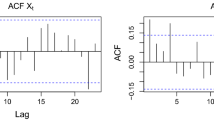Abstract
A major reason for the success of linear autoregressive (AR) modeling is that Kolmogrorov proved that every linear system could be represented by a linear AR model of infinite order. The computation of a finite order AR approximation is, of course, the practical goal. In this paper, we prove that every nonlinear system with a Volterra series expansion can be represented as a nonlinear AR model of infinite order. Our method shows how an approximation to any desired order and degree can be achieved.
Similar content being viewed by others
References
A. Arapostathis, B. Jakubczyk, H. G. Lee, S. I. Marcus, and E. D. Sontag, The effect of sampling on linear equivalence and feedback linearization,Systems and Control Letters 13 (5), 373–382, Dec. 1989.
R. W. Brockett, Nonlinear systems and differential geometry,Proc. IEEE 64, 61–72, 1976.
R. D. DeGroat, L. R. Hunt, D. A. Linebarger, and M. Verma, Discrete-time nonlinear system stability,IEEE Transactions on Circuits and Systems —I: Fundamental Theory and Applications 39 (10), 834–840, Oct. 1992.
R. D. DeGroat, D. A. Linebarger, and L. R. Hunt, Nonlinear state space modeling of sunspot data, inProc. of the Twenty-Fourth Asilomar Conf. Sig., Sys. and Computers, p. 603–607, Nov. 1990.
J. W. Grizzle and P. V. Kokotovic, Feedback linearization of sampled-data systems,IEEE Trans. Autom. Control 33 (9), 857–859, 1988.
D. J. Hill and P. J. Moylan, Connections between finite gain and asymptotic stability,IEEE Trans. Autom. Control AC-27, 931–936, 1982.
Steven M. Kay,Modern Spectral Estimation, Theory and Application, Signal Processing, Prentice-Hall, Englewood Cliffs, NJ, 1988.
A. N. Kolmogorov, Interpolation und Extrapolation von stationaren zufallingen Folgen,Bull. Acad. Sci. USSR Ser. Math. 5, 3–14, 1941.
H. G. Lee, A. Arapostathis, and S. I. Marcus, Linearization of discrete time systems,Int. J. Control 45, 1803–1822, 1987.
S. Lawrence Marple, Jr.,Modern Spectral Estimation, Signal Processing, Prentice-Hall, Engle-wood Cliffs, NJ, 1987.
M. B. Priestly,Nonlinear and Non-Stationary Time Series Analysis, Academic Press, New York, 1988.
T. Subba Rao and M. M. Gabr, An introduction to bispectral analysis and bilinear time series models, in D. Brillinger, S. Fienberg, J. Gani, J. Hartigan, and K. Krickeberg, editors,Lecture Notes in Statistics, Springer-Verlag, Berlin and New York, 1984.
W. J. Rugh,Nonlinear System Theory: The Volterra/Wiener Approach, The Johns Hopkins University Press, Baltimore, MD, 1981.
I. W. Sandberg, Approximation theorems for discrete-time systems,IEEE Tr. Circuits and Systems 38, 564–566, 1991.
I. W. Sandberg, Uniform approximation with doubly finite Volterra series,IEEE Tr. Sig. Proc. 40 (6), 1438–1442, June 1992.
H. Tong,Nonlinear Time Series, A Dynamical System Approach, Oxford Science Publication, Oxford, 1990.
M. Vidyasagar, New relationships between input-output and Lyapunov stability,IEEE Trans. Autom. Control AC-27, 481–483, 1982.
M. Vidyasagar, New directions of research in nonlinear system theory,Proceedings of the IEEE 74 (8), 1060–1090, 1986.
H. Wold,A Study in the Analysis of Stationary Time Series, Almqvist & Wiksell, Stockholm, 1954.
Author information
Authors and Affiliations
Additional information
This research was supported in part by the NSF Grant MIP-9203296 and the Texas Advanced Technology Program Grant 009741-022.
Rights and permissions
About this article
Cite this article
Hunt, L.R., DeGroat, R.D. & Linebarger, D.A. Nonlinear AR modeling. Circuits Systems and Signal Process 14, 689–705 (1995). https://doi.org/10.1007/BF01213965
Received:
Accepted:
Issue Date:
DOI: https://doi.org/10.1007/BF01213965




